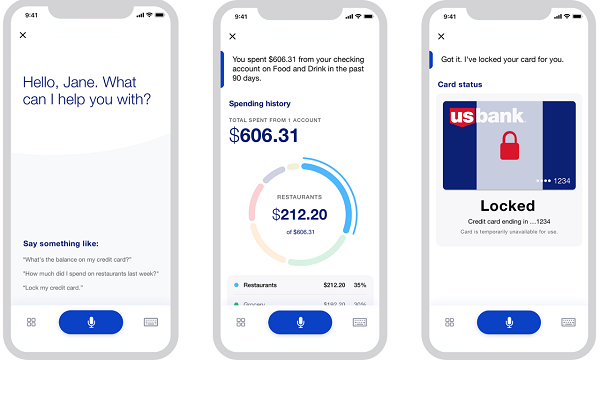U.S. Bank Launches Mobile App Voice Assistant Built to Mimic Human Bank Tellers
 U.S. Bank is launching a voice assistant for its mobile app on Wednesday, joining a growing constellation of financial institutions creating or expanding their use of voice AI. The U.S. Bank Smart Assistant allows users to carry out their banking requests using conversational language, imitating the experience of talking to a bank teller.
U.S. Bank is launching a voice assistant for its mobile app on Wednesday, joining a growing constellation of financial institutions creating or expanding their use of voice AI. The U.S. Bank Smart Assistant allows users to carry out their banking requests using conversational language, imitating the experience of talking to a bank teller.
AI Teller
The voice assistant is embedded in the U.S. Bank Android and iOS app. There’s no wake word; the AI starts listening when a user taps the microphone button in the app and will carry out transactions and transfers, pull up bills and spending history, and manage any credit cards. Should there be a request that the AI can’t fulfill, it will connect the user with a human banker using text messages or a phone call.
“The goal was to create a voice-first experience,” Ankit Bhatt, senior vice president and chief digital officer for consumer at U.S. Bank, told Voicebot in an interview. “I believe voice is a more effective medium than touch. It’s certainly faster. People can type 40 words per minute, but they can speak at about 130 words per minute. We identified early on that we wanted to create value by simplifying the experience and making it engaging. It’s more intuitive, and we really believe in its efficiency.”
Banking on Voice
Voice assistants in financial institutions are still new enough that it’s not clear if people consider them a reason to join or switch to a specific bank. Using voice technology to complete financial transactions is rising in popularity, however. Russia’s Tinkoff Bank recently added a host of new features to its Oleg voice assistant, while Bank of America’s Erica voice assistant has many millions of users. There are also companies using existing voice assistants, such as the Alexa and Google Assistant voice apps created by ICICI, one of the largest private banks in India. One of the key differentiators between those apps and U.S. Bank’s voice assistant is the central role of accessibility, Bhatt said. People with a range of sensory, cognitive, and other disabilities were involved throughout the development of the voice assistant and took part in the pilot programs.
“The accessibility division [at U.S. Bank] co-created the experience with us and provided a lot of great insight,” Bhatt said. “Designing for disability results in a better product, not just for the disabled, but for everyone.”
Future Bank
The bank began working on the voice assistant over a year ago, with internal pilots starting last October. For the natural language processing technology, U.S. Bank worked with Clinc, building on its platform with its business logic software and specialized APIs. Interviews and customer service call transcripts were used to design how the voice assistant would operate. The woman’s voice that users will hear was synthesized from a voice actor recording in a studio. Bhatt said the AI would also act as a kind of guide, helping users find and learn how to use the more than 300 features he claimed makes up the mobile app.
“The overarching goal was creating an amazing digital experience,” Bhatt said. “We’ve been investing heavily in the digital app. This is a continuation of that investment. We wanted to make sure that voice acts as a discovery mechanism for our mobile capability.”
U.S. Bank has tried out virtual assistant technology for most of a decade. The Smart Assistant isn’t the company’s first voice assistant. Nina, built on Nuance’s speech technology, debuted in 2013 as a tool for some customers using the bank’s cards, but it was never universal. Then in 2018, it launched voice apps for Alexa, Siri, and Google Assistant. The new voice assistant is unrelated to the ones on other voice assistant platforms, Bhatt said, although connections in the future are a possibility. The point of any new feature will be streamlining banking using your voice, imitating the back-and-forth with another human.
“The core experience we wanted to bring to life was the continuity of conversation,” Bhatt said. “There’s a flow we wanted to make sure we supported technically. What we’re really excited about is not just launching, but hearing feedback from customers. We’re going to learn a lot [we can] apply to the next version.”
Follow @voicebotai Follow @erichschwartz
Richard Weeks Head of Conversational Experiences at US Bank – Voicebot Podcast Ep 165
Russian Tinkoff Bank Adds Budget Watching Skills to Oleg Voice Assistant
Bank of America is Number One in New Patents for Financial Services, Upping Voice and AI Investment








